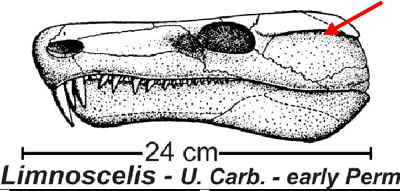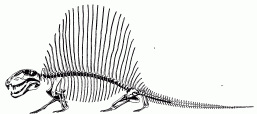
| Palaeos: Paleozoic |  |
Cisuralian Epoch |
| Permian Period | Sakmarian Age |
| Page Back | Back: Asselian | Back: Pennsylvanian | Up: Cisuralian | Unit Home |
| Page Next | Next: Artinskian | Next: Guadalupian | Timescale |

| Location | tetrapod zone | approx time |
|
India | ||||
| Age | Utah, Colorado | New Mexico | Texas | Oklahoma | Pennsylvania | Himalayas | ||
| Sakmarian | 4 | 283 284 285 286 287 288 |
Organ rock shale; | Admiral formation |
Wellington formation | Kashmir | ||
| 3 | Abo formation (Cutler group) |
Putman formation |
Green Formation (Dunkard group) |
|||||
| 2 | Hotgaita shale |
formation |
||||||

Eryops megacephalus
Horizon and Locality: Witchita Series (Wolfcampian age), Texas Red BedsSphenacodon ferocior
Horizon and Locality: from the Abo/Cutler Formation, New Mexico, USA
Dimetrodon milleri
Horizon: from the Putnam Formation, Wichita Group, Texas, USA
Ophiacodon retroversus
Horizon and Locality: Admiral Formation, Witchita Series (Wolfcampian age), Texas Red Beds
Dimetrodon limbatus
Horizon: Admiral and Bell Plains Formations, Wichita Group,| Some Links and References |
![]() Romer, A.S. and Price, L.I. Review of the Pelycosauria, Geological
Society of America Special Papers,. no.28,
Romer, A.S. and Price, L.I. Review of the Pelycosauria, Geological
Society of America Special Papers,. no.28,
![]() Robert R. Reisz, Pelycosauria,
Encyclopedia of Paleoherpetology, Part 17A, 1986, Gustav Fischer Verlag, Stuttgart and New York
Robert R. Reisz, Pelycosauria,
Encyclopedia of Paleoherpetology, Part 17A, 1986, Gustav Fischer Verlag, Stuttgart and New York
![]() The Sam Noble Oklahoma Museum of Natural History - Collections - Vertebrate Paleontology -
Lists a number of specimens of late Sakmarian age (Wellington Formation)
The Sam Noble Oklahoma Museum of Natural History - Collections - Vertebrate Paleontology -
Lists a number of specimens of late Sakmarian age (Wellington Formation)
| Page Back | Unit Home | Page Up | Page Top | Page Next |